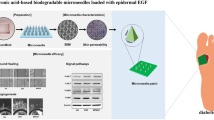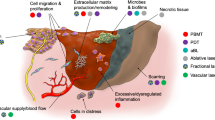Abstract
In this work, we present an oxygen-releasing insole to treat diabetic foot ulcers. The insole consists of two layers of polydimethylsiloxane: the top layer has selective laser-machined areas (to tune oxygen permeability) targeting the ulcerated foot region, while the bottom layer provides structural support and incorporates a chamber for oxygen storage. When loaded with a pressure of 150 kPa (average value for standing/walking), the insole is able to release oxygen at a rate of 1.8 mmHg/min/cm2. At lower sitting pressures, the delivery rate persists at 0.092 mmHg/ min/cm2, raising the oxygen level to an optimal healing value (50 mmHg) for a 2 × 2 cm2 wound within 150 min.




Similar content being viewed by others
References
M.G. Sheahan, A.D. Hamdan, J.R. Veraldi, C.S. McArthur, J.J. Skillman, D.R. Campbell, S.D. Scovell, F.W. LoGerfo, and F.B. Pomposelli: Lower extremity minor amputations: the roles of diabetes mellitus and timing of revascularization. J. Vasc. Surg. 42, 476 (2005).
L. Yazdanpanah, M. Nasiri, and S. Adarvishi: Literature review on the management of diabetic foot ulcer. World J. Diabetes 6, 37 (2015).
G. Han and R. Ceilley: Chronic wound healing: a review of current management and treatments. Adv. Ther. 34, 599 (2017).
M.A. Howard, R. Asmis, K.K. Evans, and T.A. Mustoe: Oxygen and wound care: a review of current therapeutic modalities and future direction. Wound Repair Regen. 21, 503 (2013).
P.G. Rodriguez, F.N. Felix, D.T. Woodley, and E.K. Shim: The role of oxygen in wound healing: a review of the literature. Dermatol. Surg. 34, 1159 (2008).
A.A. Tandara and T.A. Mustoe: Oxygen in wound healing—more than a nutrient. World J. Surg. 28, 294 (2004).
B.A. Lipsky and A.R. Berendt: Hyperbaric oxygen therapy for diabetic foot wounds: has hope hurdled hype? Diabetes Care 33, 1143 (2010).
R.J. Goldman: Hyperbaric oxygen therapy for wound healing and limb salvage: a systematic review. PM. R. 1, 471 (2009).
J. Dissemond, K. Kröger, M. Storck, A. Risse, and P. Engels: Topical oxygen wound therapies for chronic wounds: a review. JWC 24, 1 (2011).
H.K. Said, J. Hijjawi, N. Roy, J. Mogford, and T. Mustoe: Transdermal sustained-delivery oxygen improves epithelial healing in a rabbit ear wound model. Arch. Surg. 140, 998 (2005).
D. Kemp and M. Hermans: An evaluation of the efficacy of transdermal continuous oxygen therapy in patients with recalcitrant diabetic foot ulcer. J. Diabetic Foot Complications 3, 6 (2011).
P.G. Banks and C.H. Ho: A novel topical oxygen treatment for chronic and difficult-to-heal wounds: case studies. J. Spinal Cord Med. 31, 297 (2008).
G. Curran, C. Fisher, P. Hayes, I. Loftus, and L. Sequeira: Case series: the impact of NATROX® oxygen wound therapy system on patients with diabetic foot ulcers. Diabetic Foot J. 20, 193 (2017).
D. Goodridge, E. Trepman, and J.M. Embil: Health-related quality of life in diabetic patients with foot ulcers: literature review. J. Wound Ostomy Continence Nurs. 32, 368 (2005).
U.S. Department of Health and Human Services, Centers for Disease Control and Prevention, Summary Health Statistics: National Health Interview Survey, 2016, National Center for Health Statistics: MD, 2016.
L.I.F. Moura, A.M.A. Dias, E. Carvalho, and H.C. De Sousa: Recent advances on the development of wound dressings for diabetic foot ulcer treatment—a review. Acta Biomater. 9, 7093 (2013).
M.S. Khil, D. Il Cha, H.Y. Kim, I.S. Kim, and N. Bhattarai: Electrospun nanofibrous polyurethane membrane as wound dressing. J. Biomed. Mater. Res., Part B 67, 675 (2003).
H. Klank, J.P. Kutter, and O. Geschke: CO2-laser micromachining and back-end processing for rapid production of PMMA-based microfluidic systems. Lab Chip 2, 242 (2002).
M.A. Eddings, M.A. Johnson, and B.K. Gale: Determining the optimal PDMS—PDMS bonding technique for microfluidic devices. J. Micromech. Microeng. 18, 67001 (2008).
M.W. Keller, S.R. White, and N.R. Sottos: A self-healing poly(dimethyl siloxane) elastomer. Adv. Funct. Mater. 17, 2399 (2007).
M. Ochoa, R. Rahimi, J. Zhou, H. Jiang, C.K. Yoon, M. Oscai, V. Jain, T. Morken, R.H. Oliveira, D. Maddipatla, B.B. Narakathu, G.L. Campana, M.A. Zieger, R. Sood, M.Z. Atashbar, and B. Ziaie: A manufacturable smart dressing with oxygen delivery and sensing capability for chronic wound management. Proc. SPIE—Int. Soc. Opt. Eng. 10639, 48 (2018).
L. Shu, T. Hua, Y. Wang, Q. Qiao Li, D.D. Feng, and X. Tao: In-shoe plantar pressure measurement and analysis system based on fabric pressure sensing array. IEEE Trans. Inf. Technol. Biomed. 14, 767 (2010).
T.C. Merkel, V.I. Bondar, K. Nagai, B.D. Freeman, and I. Pinnau: Gas sorption, diffusion, and permeation in poly(dimethylsiloxane). J. Polym. Sci., Part B: Polym. Phys. 38, 415 (2000).
J. de Jong, R.G.H. Lammertink, and M. Wessling: Membranes and microfluidics: a review. Lab Chip 6, 1125 (2006).
A. Lamberti, S.L. Marasso, and M. Cocuzza: PDMS membranes with tunable gas permeability for microfluidic applications. RSC Adv. 4, 61415 (2014).
R.B. Fries, W.A. Wallace, S. Roy, P. Kuppusamy, V. Bergdall, G.M. Gordillo, W.S. Melvin, and C.K. Sen: Dermal excisional wound healing in pigs following treatment with topically applied pure oxygen. Mutat. Res., Fundam. Mol. Mech. Mutagen. 579, 172 (2005).
D.F. Roe, B.L. Gibbins, and D.A. Ladizinsky: Topical dissolved oxygen penetrates skin: model and method. J. Surg. Res. 159, e29 (2010).
J.T.M. Cheung and M. Zhang: Parametric design of pressure-relieving foot orthosis using statistics-based finite element method. Med. Eng. Phys. 30, 269 (2008).
C.L. Hess, M.A. Howard, and C.E. Attinger: A review of mechanical adjuncts in wound healing: hydrotherapy, ultrasound, negative pressure therapy, hyperbaric oxygen, and electrostimulation. Ann. Plast. Surg. 51, 210 (2003).
Acknowledgments
The authors would like to thank the staff at Purdue University Birck Nanotechnology Center and the Ziaie Biomedical Microdevices Laboratory members for their assistance in fabri-cation and experiments. Funding for this project was provided by NextFlex PC 1.0 Project.
Author information
Authors and Affiliations
Corresponding author
Rights and permissions
About this article
Cite this article
Jiang, H., Ochoa, M., Jain, V. et al. A laser-customizable insole for selective topical oxygen delivery to diabetic foot ulcers. MRS Communications 8, 1184–1190 (2018). https://doi.org/10.1557/mrc.2018.181
Received:
Accepted:
Published:
Issue Date:
DOI: https://doi.org/10.1557/mrc.2018.181




